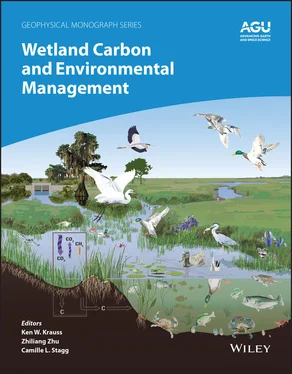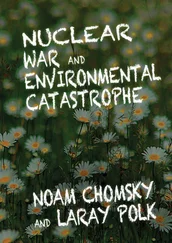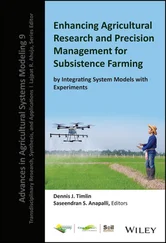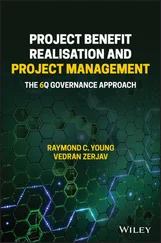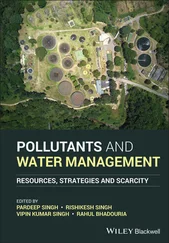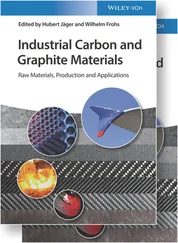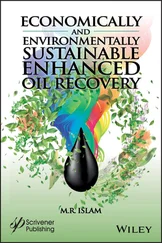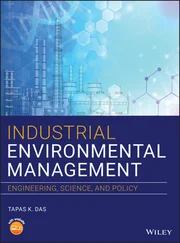401 Strack, M., Waddington, J. M., Bourbonniere, R. A., Buckton, E. L., Shaw, K., Whittington, P., & Price, J. S. (2008). Effect of water table drawdown on peatland dissolved organic carbon export and dynamics. Hydrological Processes, 22(17), 3373–3385. https://doi.org/10.1002/hyp
402 Straub, K. L., Benz, M., & Schink, B. (2001). Iron metabolism in anoxic environments at near neutral pH. FEMS Microbiology Ecology, 34, 181–186. https://doi.org/10.1111/j.1574‐6941.2001.tb00768.x
403 Streever, W. J. (2000). Spartina alterniflora marshes on dredged material: A critical review of the ongoing debate over success. Wetlands Ecology and Management, 8(5), 295–316. https://doi.org/10.1023/A:1008483203083
404 Sutter, L. A., Perry, J. E., & Chambers, R. M. (2014). Tidal freshwater marsh plant responses to low level salinity increases. Wetlands, 34(1), 167–175. https://doi.org/10.1007/s13157‐013‐0494‐x
405 Sutton, R., & Sposito, G. (2005). Molecular structure in soil humic substances: The new view. Environmental Science and Technology, 39(23), 9009–9015. https://doi.org/10.1021/es050778q
406 Taillardat, P., Thompson, B. S., Garneau, M., Trottier, K., & Friess, D. A. (2020). Climate change mitigation potential of wetlands and the cost‐effectiveness of their restoration. Interface Focus, 10, 20190129.
407 Tan, L., Ge, Z., Zhou, X., Li, S., Li, X., & Tang, J. (2020). Conversion of coastal wetlands, riparian wetlands, and peatlands increases greenhouse gas emissions: A global meta‐analysis. Global Change Biology, 26(3), 1638–1653. https://doi.org/10.1111/gcb.14933
408 Thormann, M. N. (2006). Diversity and function of fungi in peatlands: A carbon cycling perspective. Canadian Journal of Soil Science, 86, 281–293. https://doi.org/10.4141/S05‐082
409 Thormann, M. N., & Bayley, S. E. (1997). Response of aboveground net primary plant production to nitrogen and phosphorus fertilization in peatlands in southern boreal Alberta, Canada. Wetlands, 17(4), 502–512. https://doi.org/10.1007/BF03161516
410 Tobias, C. R., & Neubauer, S. C. (2019). Salt marsh biogeochemistry: An overview. In G. M. E. Perillo, E. Wolanski, D. R. Cahoon, & C. S. Hopkinson (Eds.), Coastal wetlands: An integrated ecological approach (2nd ed., pp. 539–596). Cambridge, MA: Elsevier. https://doi.org/10.1016/B978‐0‐444‐63893‐9.00016‐2539
411 Tokida, T., Miyazaki, T., Mizoguchi, M., Nagata, O., Takakai, F., Kagemoto, A., & Hatano, R. (2007). Falling atmospheric pressure as a trigger for methane ebullition from peatland. Global Biogeochemical Cycles, 21(2), 1–8. https://doi.org/10.1029/2006GB002790
412 Tolhurst, T. J., Friend, P. L., Watts, C., Wakefield, R., Black, K. S., & Paterson, D. M. (2006). The effects of rain on the erosion threshold of intertidal cohesive sediments. Aquatic Ecology, 40(4), 533–541. https://doi.org/10.1007/s10452‐004‐8058‐z
413 Torn, M. S., Trumbore, S. E., Chadwick, O. A., Vitousek, P. M., & Hendricks, D. M. (1997). Mineral control of soil organic carbon storage and turnover. Nature, 389, 170–173. https://doi.org/10.1038/38260
414 Treat, C. C., Wollheim, W. M., Varner, R. K., Grandy, A. S., Talbot, J., & Frolking, S. (2014). Temperature and peat type control CO2 and CH4 production in Alaskan permafrost peats. Global Change Biology, 20(8), 2674–2686. https://doi.org/10.1111/gcb.12572
415 Tully, K. L., Gedan, K., Epanchin‐Niell, R., Strong, A., Bernhardt, E. S., Bendor, T., et al. (2019). The invisible flood: The chemistry, ecology, and social implications of coastal saltwater intrusion. BioScience, 69(5), 368–378. https://doi.org/10.1093/biosci/biz027
416 Turetsky, M. R., Donahue, W. F., & Benscoter, B. W. (2011). Experimental drying intensifies burning and carbon losses in a northern peatland. Nature Communications, 2(1). https://doi.org/10.1038/ncomms1523
417 Turetsky, M. R., Kane, E. S., Harden, J. W., Ottmar, R. D., Manies, K. L., Hoy, E., & Kasischke, E. S. (2011). Recent acceleration of biomass burning and carbon losses in Alaskan forests and peatlands. Nature Geoscience, 4(1), 27–31. https://doi.org/10.1038/ngeo1027
418 Turetsky, M. R., Benscoter, B., Page, S. E., Rein, G., Van Der Werf, G. R., & Watts, A. (2015). Global vulnerability of peatlands to fire and carbon loss. Nature Geoscience, 8(1), 11–14. https://doi.org/10.1038/ngeo2325
419 Tzortziou, M., Neale, P. J., Osburn, C. L., Megonigal, J. P., Maie, N., & Jaffé, R. (2008). Tidal marshes as a source of optically and chemically distinctive colored dissolved organic matter in Chesapeake Bay. Limnology and Oceanography, 53(1), 148–159. https://doi.org/10.4319/lo.2008.53.1.0148
420 Tzortziou, M., Neale, P. J., Megonigal, J. P., Lee Pow, C., & Butterworth, M. (2011). Spatial gradients in dissolved carbon due to tidal marsh outwelling into a Chesapeake Bay estuary. Marine Ecology Progress Series, 426, 41–56. https://doi.org/10.3354/meps09017
421 Urbanová, Z., Picek, T., & Bárta, J. (2011). Effect of peat re‐wetting on carbon and nutrient fluxes, greenhouse gas production and diversity of methanogenic archaeal community. Ecological Engineering, 37(7), 1017–1026. https://doi.org/10.1016/j.ecoleng.2010.07.012
422 Valenzuela, E. I., Prieto‐Davó, A., López‐Lozano, N. E., Hernández‐Eligio, A., Vega‐Alvarado, L., Juárez, K., et al. (2017). Anaerobic methane oxidation driven by microbial reduction of natural organic matter in a tropical wetland. Applied and Environmental Microbiology, 83(11), 1–15. https://doi.org/10.1128/AEM.00645‐17
423 Verhoeven, J. T. A., Arheimer, B., Yin, C., & Hefting, M. M. (2006). Regional and global concerns over wetlands and water quality. Trends in Ecology and Evolution, 21(2), 96–103. https://doi.org/10.1016/j.tree.2005.11.015
424 Verma, B., Robarts, R. D., & Headley, J. V. (2003). Seasonal changes in fungal production and biomass on standing dead Scirpus lacustris litter in a northern prairie wetland. Applied and Environmental Microbiology, 69(2), 1043–1050. https://doi.org/10.1128/AEM.69.2.1043‐1050.2003
425 Vile, M. A., Bridgham, S. D., & Wieder, R. K. (2003). Response of anaerobic carbon mineralization rates to sulfate amendments in a boreal peatland. Ecological Applications, 13(3), 720–734. https://doi.org/10.1890/1051‐0761(2003)013[0720:ROACMR]2.0.CO;2
426 Villa, J. A., Ju, Y., Stephen, T., Rey‐Sanchez, C., Wrighton, K. C., & Bohrer, G. (2020). Plant‐mediated methane transport in emergent and floating‐leaved species of a temperate freshwater mineral‐soil wetland. Limnology and Oceanography, 65(7), 1635–1650. https://doi.org/10.1002/lno.11467
427 Visser, J. M., Franken, F., & Sasser, C. E. (1999). Effects of grazing on the recovery of oligohaline marshes impacted by Hurricane Andrew. In: L. P. Rozas, J. A. Nyman, C. E. Proffitt, N. N. Rabalais, D. J. Reed, & R. E. Turner (Eds.), Recent Research in Coastal Louisiana: Natural System Function and Response to Human Influence (pp. 295–304). Louisiana Sea Grant College.
428 Waddington, J. M., Strack, M., & Greenwood, M. J. (2010). Toward restoring the net carbon sink function of degraded peatlands: Short‐term response in CO2 exchange to ecosystem‐scale restoration. Journal of Geophysical Research, 115(G1), 1–13. https://doi.org/10.1029/2009jg001090
429 Walter, K. M., Zimov, S. A., Chanton, J. P., Verbyla, D., & Chapin III, F. S. (2006). Methane bubbling from Siberian thaw lakes as a positive feedback to climate warming. Nature, 443(7107), 71–75. https://doi.org/10.1038/nature05040
430 Wand, S. J. E., Midgley, G. F., Jones, M. H., & Curtis, P. S. (1999). Responses of wild C4 and C3 grass (Poaceae) species to elevated atmospheric CO2 concentration: A meta‐analytic test of current theories and perceptions. Global Change Biology, 5, 723–741. https://doi.org/10.1046/j.1365‐2486.1999.00265.x
Читать дальше
